Including Community Voices - and Services - as We Close Rikers and Build New Jails
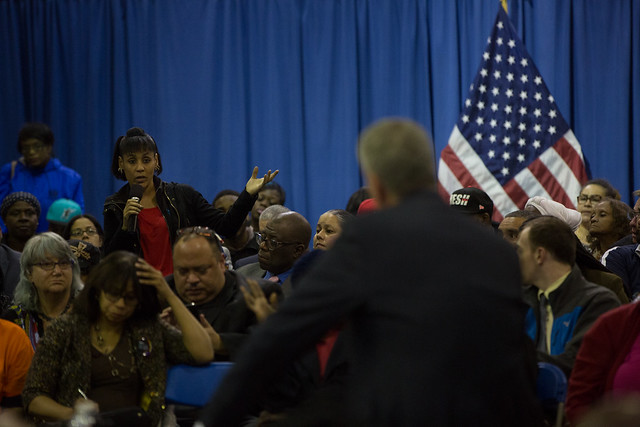
(photo: Michael Appleton/Mayoral Photography Office)
If you would have told New Yorkers seven years ago that the jails on Rikers Island would be closing, they would have not believed you.
Until recently, shutting down the infamous complex was roundly dismissed as a radical idea that was not likely to be achieved during our lifetimes. However, what was once a dream for many people is now closer to becoming reality due to the hard work of brave New York City advocates and a number of forward-thinking organizations who have worked tirelessly to shed light on the principal concerns that fueled the Close Rikers campaign.
We must continue to fight for the decarceration of New Yorkers by demanding bail reform and alternatives to incarceration for all who are awaiting trial or are sentenced to one year or less in our jails. Over the last year, community conversations about the plan to close Rikers jails have shifted to a debate about the location and heights of the new community facilities that will replace the jails on Rikers. As we continue listening and creating a dialogue with our neighbors, we cannot lose sight of our collective mission: to build a more humane justice system.
The question we must ask is: how can any new facility and its surroundings reflect who we are as a community?
Research on reducing recidivism and incarceration stresses the importance of a multi-faceted approach. Strengthening social ties through community programming, improving economic opportunity through job training and quality education, and expanding access to quality housing and healthcare all contribute to better outcomes for at-risk populations.
I know firsthand how important these programs are to help change lives and communities as a whole. In Mott Haven in the Bronx, the community I call home, I am part of a community-based organization that stresses the importance of education, civic participation, and economic development to people of all ages.
I have led educational programs, life-skills development trainings, and individualized support to get at-risk youth back on the right track. In fact, three young people who were once labeled at-risk and disconnected youth used these programs as an opportunity to redefine themselves into successful young adults who now give back to their community, and I later hired each of them as program directors. They have become some of Mott Haven’s most vocal community leaders.
In the coming years, advocating for these programs will become critically important to overhauling a status quo that simply has not been working.
Additionally, according to the Independent Commission on New York City Criminal Justice and Incarceration Reform, New York City will save over $1.6 billion annually if the jails on Rikers close and a modern, smaller system replaces them. Our communities will need to decide how that money is spent.
Advocates must push to have savings from the closure of the Rikers jails reinvested back into the communities that have historically shouldered the cost of our unjust legal system. As the city looks to place jails in areas like Mott Haven, near my home in the Bronx, we must ensure that these projects include services and resources that have a positive effect on the community and reduce the incarcerated population. As a Bronx Neighborhood Advisory Committee member, this is exactly what I and other members have been advocating for as we advise city government on how to proceed.
The Bronx Neighborhood Advisory Committee is a diverse group of committed and dedicated Bronx residents who have been working diligently to secure true sustained investment in the Mott Haven community. We have spent months developing recommendations focused on improving quality of life by ensuring that our neighborhood receives services and investments in the areas of health, recreation, economic development, education, and housing.
Some of these recommendations include building affordable housing for Bronx residents, investing in youth by upgrading community centers in the surrounding areas and providing programming, and providing healthy food options for the residents of Mott Haven while also educating the community on healthy food practices to transform Mott Haven from a food desert into a healthy food oasis.
Doing so will help make our children more healthy and give them a real shot at success in the future while also giving Bronx community members an opportunity to participate in our economy, establish businesses, and help our community flourish.
As the city continues to seek community input on plans to open more humane jails in our neighborhoods, not only do we have an opportunity to bring real investments in our community, but the chance to be on the right side of history. We have an opportunity to fundamentally change our justice system and take a significant step toward ending the era of mass incarceration.
***
Althea Stevens is a Mott Haven community member and part of the Neighborhood Advisory Council, which has advised the city on its borough-based jails plan.
***
Have an op-ed idea or submission for Gotham Gazette? Email This email address is being protected from spambots. You need JavaScript enabled to view it.
Ensuring Others Don’t Face the Injustice I Did: Why Rory Lancman is the Right Candidate for Queens DA

Valerie Bell, the author, left; Rory Lancman; and Gwen Carr
On November 25, 2006, my son Sean Bell was killed in a hail of 50 bullets from the NYPD on his wedding day. The officers who killed my son were acquitted due to the lack of an unbiased relationship between the judge and the Queens district attorney. Sean never received the justice he deserved and the men that murdered my son suffered no consequences under the law.
Subsequent to this marred process of criminal justice, I worked diligently alongside other mothers who were victims of police brutality to request Governor Cuomo use his authority under the law to appoint a Special Prosecutor in the Attorney General's office to investigate police use of deadly force. The governor supported our view and a Special Prosecutor was granted.
Since meeting City Council Member Rory Lancman, I’ve learned he has always been in relentless pursuit of police accountability. He has been, and continues to be a guardian against the racial disparities of law enforcement in communities of color, and this is why I am supporting Rory Lancman to be the next District Attorney in Queens.
As I have seen firsthand, criminal justice in Queens is stuck in the past, but for the first time in almost 30 years, the people of Queens have the power to elect a new District Attorney. The current Queens DA's office led the opposition to creating a Prosecutorial Misconduct Commission, and is the only DA's office in New York City that refuses to have a wrongful conviction review unit.
The office has opposed closing Rikers Island, and refuses to follow the lead of other District Attorneys who no longer prosecute most fare evasion and marijuana possession cases; 90% of such prosecutions are people of color. Queens’ 2.3 million people deserve better than a 'lock ‘em up and throw away the key' mentality.
For these reasons and more, Rory Lancman needs to be the next District Attorney in Queens.
Rory understands that our criminal justice system is built on a foundation of institutional racism. That racism manifests itself in a number of ways: massive discrepancies in communities of color for low-level arrests, broken windows policing that terrorizes black and brown communities, and a system that sets up even innocent people to plead guilty rather than endure the nightmare of Rikers Island while waiting for their day in court.
My family never received justice for what happened to Sean. Gwen Carr and her family never received justice for what happened to Eric Garner. Instead of just lamenting problems, Rory has gotten to work. He’s sponsored legislation that would outlaw police chokeholds, and has fought against the misuse of New York's so-called “50-A Law” to shield police officers from public scrutiny of prior misconduct. As our next Queens District Attorney, Rory will not tolerate police malfeasance, whether it is violence against law-abiding citizens or perjury in the courtroom.
Finally, Rory will be a true criminal justice reformer at a time when Queens desperately needs it. Rory’s vision is simple: create a fair system that treats everyone equally, and that views incarceration as a last resort for real crimes. Too many of our young people are given criminal records for the rest of their lives that make it hard for them to get an education, job, and housing.
On June 25, Queens will face a stark choice in choosing a new District Attorney. The District Attorney has incredible power over people's lives. Queens is long overdue for a true reformer who will make sure the law works for everyone, and will hold even the powerful accountable. That person is Rory Lancman.
***
Valerie Bell is the mother of Sean Bell.
***
Have an op-ed idea or submission for Gotham Gazette? Email This email address is being protected from spambots. You need JavaScript enabled to view it.
Taxi Medallion Exposé Drives Home Key Budget Lesson
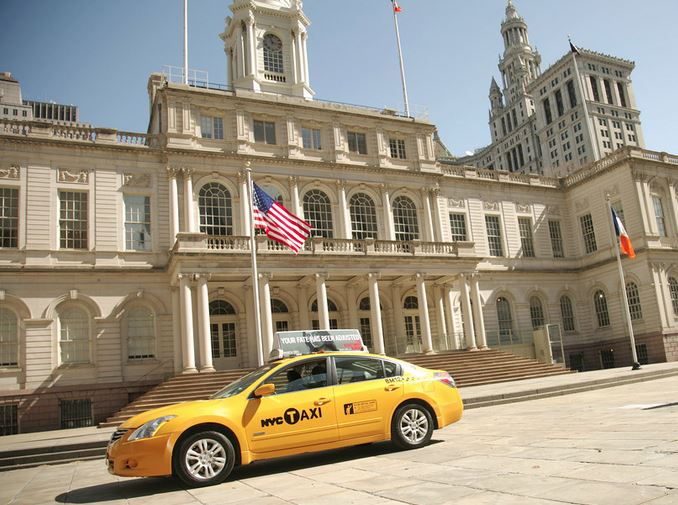
(Photo: Ed Reed/City Council)
Last week, the New York Times published another blockbuster investigative series by reporter Brian Rosenthal, this time on the misleading and predatory practices which led to inflated prices of New York City yellow taxi medallions over the last decade.
The compelling stories of taxi drivers who thought they were buying into the American dream by purchasing taxi medallions, only to find their incomes drastically reduced by the competition of Uber and Lyft, has been a topic of public discussion for some time, but Rosenthal’s reporting provides new and detailed documentation of how lenders and brokers drove up the prices and encouraged purchases without concern as to whether the buyers had the wherewithal to repay their loans.
The story is reminiscent of the over-leveraged home buying encouraged and condoned by financial services firms and banks that contributed to the national housing bubble and the recession in 2008.
In his second article on the taxi industry, Rosenthal focused on the regulatory agencies that seemingly should have known something was wrong when medallion prices skyrocketed but did nothing to intervene. Indeed, the New York City Taxi and Limousine Commission even ran ads promoting medallion sales as a great investment. State and city officials are now investigating; legislators are looking at ways to aid struggling medallion owners.
The situation of many taxi drivers and their families (especially those who have died by suicide) is unspeakably sad and it is understandable that elected leaders want to help them. But the rise and fall of taxi medallion prices also contains a larger message and lesson for government about the dangers and unintended consequences of relying on one-time revenues to fund government expenses.
Fiscal watchdogs warn against reliance on “one-shots” because they artificially inflate the amount of revenue available and will have to be replaced by other resources over the long term. That is why organizations like Citizens Budget Commission (CBC) urge that one-time windfalls be used to pay down debt or bolster reserves, not to start new programs or pay for employee salaries and benefits.
CBC has repeatedly criticized the city for including large amounts of anticipated taxi medallion sales revenue in its financial plans since it began doing so in 2011:
“Balancing the budget with these one-shots does not address the structural problems– notably, escalating health insurance and debt service costs—but masks the problem temporarily and delays the discourse needed to adopt more enduring, if politically tougher, solutions. In addition, one-shots can be unreliable; if something does not work as anticipated, the savings will not materialize.”
The same concern holds true for one-shots at the state level. New York state government has received over $11 billion in one-time revenue from settlements of litigation with financial institutions over the past five years. This funding has been used for a variety of initiatives, from infusions into economic development schemes like the “Buffalo Billion” to front end development and construction costs of the Mario M. Cuomo Bridge. Regardless of the merits of these projects, it would have been more prudent and appropriate to use these one-time revenues to reduce the state’s indebtedness and/or increase its rainy day reserves to be better prepared for the inevitable time when there is an economic downturn.
And Rosenthal’s investigation highlights another reason for avoiding reliance on one-shots: not only do they obscure the city’s true fiscal picture but they can create pressure on officials – albeit sometimes unintentional or even unconscious – to maximize resources to fill a budgetary need.
The city has repeatedly included as much as $1.5 billion in taxi medallion sales revenue in its four-year financial plans. This is a great deal of revenue and suggestions that it might be achieved through unfair means would probably not have been favorably received by budget directors happy to have this revenue in their projections to reduce out-year deficits. No one was motivated to look a gift horse in the mouth.
The state and city comptrollers have joined CBC in criticizing the city’s reliance on medallion sales receipts and the amount expected has been reduced and stretched out over longer lengths of time as the market changed and then tanked, and was completely removed from the mayor’s executive budget starting in fiscal year 2019 and since.
It would be a great irony if, instead of leading to more than a billion in revenue, the taxi medallion market’s problems lead to significant city spending to purchase owners’ loans or bail them out in some other way, as some legislators are contemplating. The lesson is that when a sudden and untested revenue source appears, don’t count on it because it may well be too good to be true.
***
Carol Kellermann was president of Citizens Budget Commission from 2008 through 2018.
***
Have an op-ed idea or submission for Gotham Gazette? Email This email address is being protected from spambots. You need JavaScript enabled to view it.
***
Have an op-ed idea or submission for Gotham Gazette? Email This email address is being protected from spambots. You need JavaScript enabled to view it.
New York City Must Fully Restore Article 6 Public Health Budget Cuts

(photo: William Alatriste/City Council)
As health care providers and public health advocates, we believe that all New Yorkers deserve access to high-quality, comprehensive, compassionate health care. We believe that health care is a human right—not a luxury for the privileged.
And yet, New York State has cut vital public health programs for our city—and only our city. Known as Article 6, these state funds help support critical services provided by local health departments, including immunizations; tuberculosis outreach, education and testing; and sexual and reproductive health. In New York’s most recent budget, New York City’s reimbursement for this program was cut by 16%, resulting in more than $62 million in lost funding to essential city public health programs.
The Mayor’s Executive Budget plan includes $59 million in funding to restore cuts to the Department of Mental Health and Hygiene administrative programs and organizations funded by the administration. However, it does not cover the millions in lost Article 6 matching funding for City Council discretionary-budget public health programs, such as those that support immigrant health, health education, health insurance access, HIV/AIDS prevention and treatment, child and maternal health, viral hepatitis, and more.
Currently, the City Council estimates cuts will result in no less than $3.4 million in lost funding across dozens of community-based organizations.
We are calling upon Mayor de Blasio and the City Council to stand up for our communities and say no to these cuts to our health care funding. We are calling for this funding to be fully restored in the city’s fiscal year 2020 budget, which is due by July 1, including full funding for Council-discretionary funded nonprofit providers.
Funding for City Council public health initiatives is a small fraction of the $90-plus billion city budget. We can't afford to not invest in public health.
Lack of access to quality health care can lead to devastating outcomes, from premature death to high prevalence of chronic diseases, especially in our most vulnerable communities. The leading causes of illness, disability, and death in New York City are largely preventable. Clinical encounters with medical staff are critical opportunities for health promotion and disease prevention and treatment, yet many New Yorkers face egregious barriers to accessing care.
New York City has a long way to go before all our communities are able to access the health care they need and deserve to lead healthy, autonomous lives. We are on the ground every day, from the Bronx to Staten Island, providing care to those who need it most. We still have so much work to do—and what we need is more support for our lifesaving work, not a budget cut that threatens our progress and our communities’ health and futures.
***
By Anthony Feliciano, Executive Director of Commission on the Public’s Health System; Laura McQuade, President and CEO of Planned Parenthood of New York City; Mark Harrington, Executive Director of Treatment Action Group; Jennifer March, Executive Director, Citizens’ Committee for Children of New York; and Charles King, CEO and co-founder, Housing Works.
***
Have an op-ed idea or submission for Gotham Gazette? Email This email address is being protected from spambots. You need JavaScript enabled to view it.
More Sites, Better Democracy: Board of Elections Must Get Early Voting Right
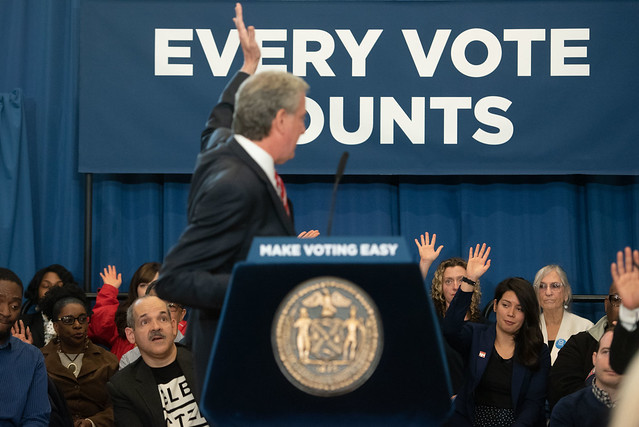
(photo: Michael Appleton/Mayor's Office)
Early voting has finally come to our state, but it won’t work in our city unless the City Board of Elections ensures there are enough voting sites. That needs to happen, and it needs to happen now for our 3 million immigrants, our communities of color and every New Yorker who has a hard time voting on Election Day.
Later today, the BOE is due to announce how many early voting poll sites New York City will have for the November election – the first time New Yorkers will have the right to vote early.
The preliminary list the BOE released last month, which included just 38 sites, was not enough and seemed designed to undermine the idea of early voting itself. Let’s think about how preposterous just 38 voting sites would be in a city that stretches out over 300 square miles, and how far out of the way New Yorkers may need to travel to get to the nearest early voting site assigned to them. For example, if you live in upper Manhattan but want to vote early near your job downtown, or even if you want to vote close to home but the nearest of just 38 sites is too far, you won’t be able to under BOE's plan. This is restrictive and counter intuitive to the spirit and letter of the law, which is supposed to make voting as convenient as possible. New Yorkers deserve more time to participate in our democracy, not just on Election Day.
Early voting gives New Yorkers nine days before Election Day to cast their ballot – including two weekends. That isn’t a luxury. It’s a necessity for millions of citizens whose schedules are filled to the brim with work, school and/or family commitments. The fact that until now New York State has restricted voting to a single day has contributed to two awful realities: voter turnout has been at historic lows and Election Day is plagued with long lines for those who do show up to exercise their right. This is on top of arcane, confusing rules that are near impossible to comprehend, particularly for limited-English-proficient New Yorkers and immigrant citizens.
The last November General Election was a prime example of many of the challenges New Yorkers faced when they went out to the polls, making lines even longer than usual. At one point, ballot scanners that had been malfunctioning all day at M.S. 80 in the Bronx all broke down, bringing voting to a dead stop. This same problem at St. Cecilia's in Greenpoint led to hundreds of voters waiting up to four hours to cast their ballot. At other sites like Christ Church in Bay Ridge, the size of the new ballots caused a myriad of scanning problems that led to similar, massive delays.
The problem will only get worse as the BOE continues to ignore calls for reform and as New Yorkers get more energized for upcoming elections.
We have a chance to make things right. This year, the New York Legislature did its job and passed a package of election reforms, including early voting. But the BOE – which is funded by New York City and yet independent of City control – isn’t living up to its responsibility.
Under the current proposal, more than a third, or 21 out of a total of 51 City Council districts, wouldn’t have a single early voting site. In the borough of Queens alone, there are almost 1.2 million voters and more than 1 million immigrants. Yet, the BOE’s initial plan sited just seven early voting locations in the whole borough. With xenophobia and racism rearing their heads at the highest levels of government, the BOE has effectively excluded immigrant neighborhoods and communities of color from proximity to early voting sites, suppressing the voices of minorities in our elections. The BOE can and must do better.
Today we’re waiting to see whether the BOE takes up the City’s offer and expands its original 38 sites to 100. With the 2020 elections fast approaching, it’s vitally important that we maximize opportunities for our city’s five million registered voters. Their voices guide the City in all that it does.
This is a moment that should anger anyone who believes in democracy, anyone who believes in the empowerment of our City’s immigrants, and the rights of all eligible voters to make their voices heard.
New York City has provided $75 million for a robust early voting program, and now the BOE needs to step up to the plate and do its job by making early voting available to every registered voter, in every borough. Otherwise, the promise of early voting and of this democracy will be betrayed.
***
Bill de Blasio is Mayor of New York City. Steve Choi is Executive Director of the New York Immigration Coalition. On Twitter @NYCMayor & @SteveChoiNY.
***
Have an op-ed idea or submission for Gotham Gazette? Email This email address is being protected from spambots. You need JavaScript enabled to view it.
New York City Should Give ‘Democracy Dollars’ to Kids
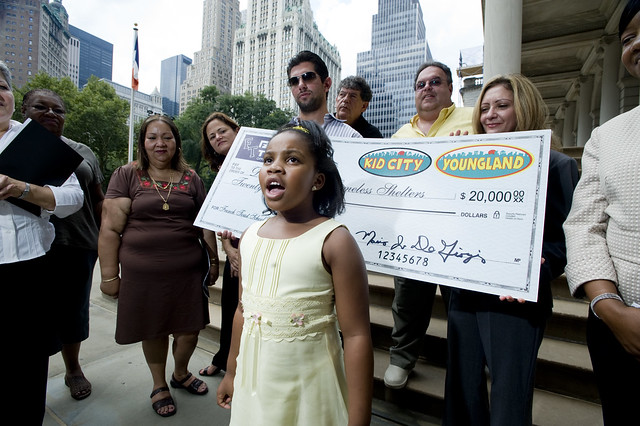
(photo: William Alatriste/City Council)
Senator and presidential candidate Kirsten Gillibrand wants to give all Americans $600 to donate to candidates for office. She believes this will level the campaign finance playing field and ween candidates from the corrupting influence of large donors and corporate PACs.
This is a well-meaning reform based on early success of the Democracy Voucher Program in Seattle, Washington, to diversify the pool of donors, yet it misses an important point. By restricting “Democracy Dollars” to eligible voters, one of our most important constituencies is again left out: young people.
According to the Pew Research Center, the pool of donors is as biased toward older voters as it is toward the wealthy and highly educated. A third of those over the age of 65 report giving a campaign donation compared to less than 10% of those 18-29 years old. In Seattle, older voters are much more likely to use a Democracy Voucher than younger voters, and minors are not even eligible.
Is it any wonder that New York City classrooms are crumbling and segregation continues to plague our schools? On issues that are most likely to affect young people in the future -- from quality schools to climate change to the ballooning federal debt -- lawmakers remain unable to find long-term solutions.
This is in part because the political voice of young people is muffled until they become eligible to vote at age 18, and after due to low voter turnout. As former Mayor Ed Koch famously quipped, “You don’t vote, you don’t count.”
Interestingly, federal law does not bar young people from making campaign contributions. In 2005, the U.S. Supreme Court found restrictions on campaign donations from minors unconstitutional. And Participatory Budgeting in New York City is already open to everyone over the age of 11.
This opens a window of opportunity for the city to continue to innovate in the area of equitable campaign finance. While the city’s existing Matching Funds Program does not match donations from minors, a new “Democracy Voucher Program for the Future” targeted at high school students could empower the leaders of the city in the decades to come.
Similar to Senator Gillibrand’s proposal, the approximately 400,000 students attending public and private New York City high schools would receive $5 vouchers that they could donate to eligible candidates for office. If students were each allotted two vouchers, this would generate a pool of up to $4 million.
This new program would potentially re-orient campaigns toward a newly powerful class of donors. Candidates would be compelled to articulate their views on the issues young people care about. Young people would be able to support candidates that speak to their issues and share a vision for the future of the city.
The program would also serve as a basis for high schools to encourage real political participation, not just theoretical. And in the longer-term, establishing the habit of political participation in high school is likely to greatly increase voter participation when students later become eligible.
Yes, the image of candidates soliciting donations on the steps of a local high school is strange. But, is it any stranger than courting developers at swanky restaurants or city contractors at private parties?
If you believe in changing the corrupting influence of big money in politics and energizing those left out of politics, then you should support empowering the city’s young people.
***
Heath Brown is associate professor of public policy at City University of New York, John Jay College and CUNY Graduate Center, and the author of Pay to Play Politics. On Twitter @heathbrown.
***
Have an op-ed idea or submission for Gotham Gazette? Email This email address is being protected from spambots. You need JavaScript enabled to view it.
A Closer Look at New York City Latino Voter Participation in the 2018 Elections
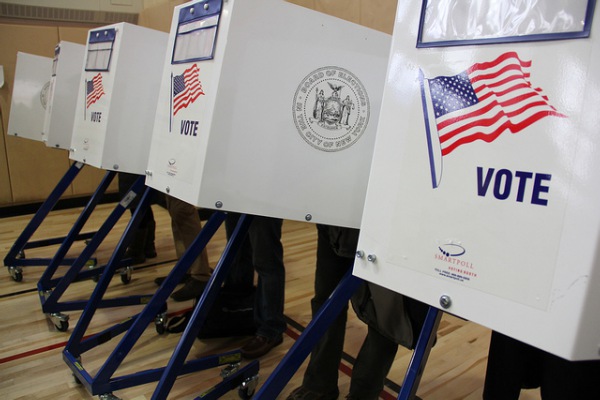
(photo: Mayor's Office)
NYC Votes and the Voter Assistance Advisory Committee recently released their mandated report regarding voting participation in New York City, which skyrocketed in 2018. While the report contains fascinating analyses, it does not, nor does it seek to, delve into the role that people of color, in this case specifically Latinos, played in last year’s elections. But their role was definitely pivotal, and it particularly affected the New York gubernatorial primary.
According to my own analysis, over half a million more voters came out to the polls in the 2018 Democratic primaries than in the 2014 primaries. Over a million more voters voted in the 2018 general election than in the 2014 general election.
This enormous increase in voting participation was evident across all racial groups. But of them all, the increase among Latino voters in New York City was slightly greater. Compared to the 2014 primaries, when Latinos comprised 17% of the overall New York City electorate (47,592 voters), in 2018 Latinos increased their voter share to 20% of the city electorate, with 169,667 Latinos going to the polls.
In the 2018 general election Latinos also comprised 20% of the city’s electorate, increasing their voter turnout by nearly 300,000 voters over the 2014 general election.
Of these, 55% of the Latino vote came from two boroughs—the Bronx and Manhattan—and 42% of the Latino vote came from Brooklyn and Queens. One interesting change from previous elections is that the Latino vote in Queens has increased. In previous years, Manhattan made up almost 30% of all Latino voters but that number is now dwindling, in my estimation likely because of the decrease in Puerto Rican voters in East Harlem and the Lower East Side.
But Queens has seen a spike in Latino voting participation, with 30,000 more voters going to the polls in 2018 than in 2014. Queens Latino voters now comprise 21% of all Latino voters in the city, the largest increase in percentages of all the boroughs. In the 2018 general election, Queens residents made up a quarter of all Latino voters. The Bronx remains the borough with the most Latino voters.
Lest you think this column is painting too rosy a picture of Latino voting participation, here’s the reality check: only 20% of all eligible Latino Democratic voters in New York City voted in the 2018 Democratic primary. In the 2018 general election, 37% of all eligible registered Latinos voted in New York City. In comparison, 45% of registered black voters in the city went to the polls in the general election.
To be sure, the lack of Latino voting participation in New York City is not unique to Gotham. Studies indicate that this lack of participation is prevalent nationally. This has been well documented by Bernard Fraga in his book The Turnout Gap. There, Fraga observes on the basis of careful research that Latino (along with Asian-American) voting participation lags behind all other groups nationally.
Clearly, much remains to be done when it comes to pushing for a greater electoral presence among Latinos. The question is whether its leaders, particularly Latino elected officials, have the wherewithal to make this a priority.
The most recent citywide election (the February special election for public advocate) barely turned out 10% of Latino voters. Granted, all political observers predicted that this election would be a low-turnout affair. But the abysmal turnout among Latinos should raise many questions of concern and should compel Latino leaders to strategize ways to increase voting participation. Otherwise, the “sleeping giant” moniker given to Latinos will persist.
***
Eli Valentin teaches political science at Monroe College and is a frequent guest political analyst on Univision NY. On Twitter @elivalentinNY.
***
Have an op-ed idea or submission for Gotham Gazette? Email This email address is being protected from spambots. You need JavaScript enabled to view it.
State Lawmakers Must Help Launch a New Era of NYPD Transparency and Accountability
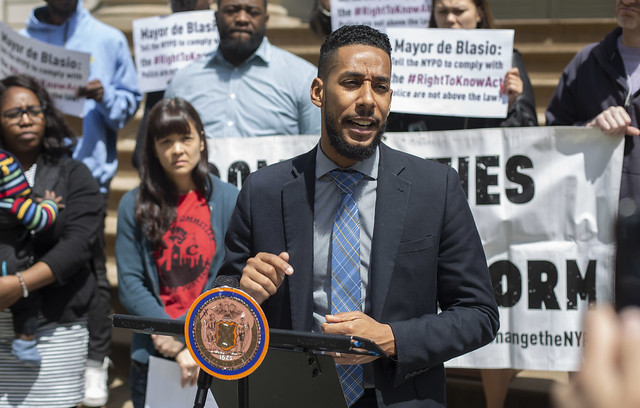
Council Member Reynoso, one of the co-authors (photo: John McCarten/City Council)
In recent history, New Yorkers have witnessed numerous instances of brutality and mistreatment at the hands of the police. Justice has not been delivered in many of these cases, and they all point to a glaring reality: a lack of transparency and accountability plagues the New York City Police Department.
The public was vividly reminded of this just a few weeks ago when a video of Christopher Parham’s 2018 arrest surfaced. In the video, 19-year-old Parham is seen picking up groceries for the restaurant where he worked when three plainclothes officers followed him outside of the grocery store and threw him to the ground, violently arresting him without cause. The officer who took him into custody – an officer with a history of civil rights lawsuits – and his colleagues slammed his head onto the sidewalk of a busy Williamsburg street, giving him a concussion and tasing him repeatedly before dragging him backwards by his handcuffed arms into a police car.
Despite the fact that this brutal assault occurred in broad daylight in front of witnesses, and was captured on cell phones and security camera, paperwork completed by the NYPD indicated that no force had been used during the arrest. The NYPD says an internal investigation cleared the officers who attacked him of wrongdoing.
The charges filed against Parham were eventually dismissed following the District Attorney’s review of surveillance footage obtained by Brooklyn Defender Services and our partnership advocating on his behalf. However, Parham’s experience with law enforcement is not unique, and residents of New York City are not strangers to officers with problematic histories patrolling their streets.
Stories like Parham’s are why we support the SaferNY Act, a package of bills currently in the New York State Legislature that aims to increase police accountability through measures such as repealing section 50-a of the state’s Civil Rights Law, which shields police personnel records; enacting the Police Statistics and Transparency (STAT) Act; and strengthening the role of the Special Prosecutor currently enacted by executive order.
Police departments in New York are tasked with disciplining their own officers, which means that officers who commit crimes, ranging from lying under oath to murder, are allowed to keep their jobs, even after an assessment of potential wrongdoing has been made. In this enormously flawed law enforcement disciplinary system – one where, for example, a finding of wrongdoing by the New York City Civilian Complaint Review Board and Internal Affairs Bureau investigations does not guarantee that officers are penalized – the personnel records of police officers remain sealed under 50-a.
Under 50-a, the information contained in personnel files, including investigations and findings of fact, are sealed from public scrutiny. This is problematic because the publicly available records paint an incomplete picture, one that judges and prosecutors are all too able to ignore at the NYPD’s urging. As a result, even when numerous public civil lawsuits have been filed, they are not considered as findings of fact or determinations of guilt and most of these cases settle out of court.
The public is starting to learn of some of the most problematic cases and worst offenders, however they have yet to be held accountable. As an example, Sgt. David “Bullethead” Grieco has been named in more than 30 lawsuits with allegations including physical violence and lying under oath. Yet despite his egregious track record, cases brought by this officer are still being prosecuted.
If we want a city that is safe, fair, and equitable, we must hold all citizens to the same standards and levels of accountability, including members of our law enforcement. It shouldn’t take a City Council member and advocates to join forces to protect individuals like Christopher Parham from those who are supposed to protect us.
Parham wants to move on with his life, “I just don’t want this to happen to anyone else,” he says. It is in the hands of the New York State Legislature to get us closer to this goal, and that is why we urge our state lawmakers to pass the SaferNY Act before the end of this session in Albany.
***
City Council Member Antonio Reynoso represents parts of Brooklyn and Queens. Lisa Schreibersdorf is Executive Director and Founder of Brooklyn Defender Services. On Twitter @CMReynoso34 & @lisaschreib.
***
Have an op-ed idea or submission for Gotham Gazette? Email This email address is being protected from spambots. You need JavaScript enabled to view it.
Reorganizing the MTA with a Transparent, Public Process
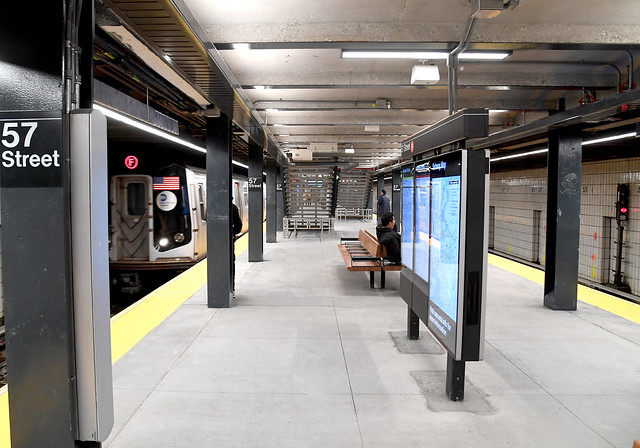
(photo: Marc A. Hermann / MTA New York City Transit)
In advance of the MTA Board meeting taking place today (Wednesday, May 22), Reinvent Albany and ten other groups including Riders Alliance, TransitCenter, Regional Plan Association, and others sent a letter asking the Metropolitan Transportation Authority (MTA) to make sure that the process for developing its reorganization plan -- as required by this year’s state budget -- is public, transparent and consultative.
At a time when the MTA has been seeking to restore the public’s trust, it is as important as ever that a reorganization is not disruptive to riders, who are counting on a reorganization to provide better, not worse, service. Ensuring the discussions over the pending reorganization are open and consultative will help put the MTA’s best foot forward to show it is acting in the public interest -- something highlighted as a major need in Reinvent Albany’s recently-released Open MTA report.
So far, the process has not been public or transparent, and MTA Board members have raised important questions about their role. In March, before the state budget legislation was passed creating the mandate for reorganization, the Board was asked by MTA management to approve a contract with consultants AlixPartners. Once the budget was finalized and passed, at the April Board meeting, a $4 million contract was approved for AlixPartners to develop the reorganization plan.
While the law sets up milestones for the process to unfold, there is no detail on how the public is to be engaged in the process, and little detail on how the plan is to be presented to the public. The state budget requires the MTA’s consultant, now AlixPartners, to give its plan to the MTA Board by June 30 of this year. Our view is that the plan should be made public at that date, including any accompanying analyses.
AlixPartners is also conducting a “review” of waste, fraud, abuse, conflicts of interest, duplications of functions, etc., which is due to the MTA by July 31. Under law, the “review” is to be made public within 30 days of receipt by the MTA.
Best would be to make the AlixPartners “review” public as soon as it is received by the MTA Board, since there is a narrow window of time for adopting the reorganization plan. Within 90 days of receipt of this “review,” the reorganization plan is to be “updated” by the authority to incorporate its findings.
It is our understanding that the MTA Board, acting as the authority, will vote on a final reorganization plan sometime before the end of October of this year. Well before a final plan is voted on, the MTA Board and staff should reach out to public stakeholders, including riders groups, unions, advocates, and elected representatives, and publicly consult with them about potential recommendations. This would be best done outside of the MTA Board meeting process, which limits public engagement to 2-minute presentations and does not allow a dialogue to occur.
Beyond ensuring that the reorganization plan process is open and consultative, as supported by our partners, Reinvent Albany has a number of questions about the ramifications of the plan itself that we would like the MTA to answer:
- The MTA’s efforts to consolidate invoice payments, human resources, and IT functions under the Business Services Center (BSC) have not been independently evaluated, though general consensus is that the effort was rocky at first, though appears to be moving in the right direction. What has the MTA learned from this past consolidation that should apply to the current reorganization process? Reports on the BSC from MTA show that its current mandate is considerable.
- How will the plan ensure that the MTA’s professional staff are allowed to have independence, and be free from the past politicization that has plagued the MTA?
- What will be the role of agency presidents going forward? Andy Byford has hired considerable talent, including, for example, Sarah Meyer (Chief Customer Officer), and Pete Tomlin (signals technology expert). How will this staff talent be retained and used in the future?
- How will the plan ensure that there is not further brain drain, and work to boost MTA staff morale? The hiring freeze has put considerable strain on current MTA staff to already do more with fewer resources (in some cases necessitating overtime), and morale appears to be at an all time low.
- How will the state budget provision that enables sharing of employees facilitate reorganization? How will any sharing of employees be reported to the MTA Board and public? How will collective bargaining agreements affect the proposed reorganization/employee sharing?
- How will the plan address transparency and accountability? MTA CEO/Chair Pat Foye has promised to overhaul the Freedom of Information Law (FOIL) process and Open Data at MTA, yet the Information Technology (IT) department has already been consolidated, resulting in the elimination of 187 positions, in addition to the current hiring freeze.
Reinvent Albany also has concerns that this IT consolidation is creating an outsourcing trap for the MTA that results in dependency on outside, costly consultants. Transparent efficiency efforts rely on IT staff having the people, resources, and political will to make changes. Will they?
The MTA should seek to answer these questions -- and those of other stakeholders -- in a public, consultative process. MTA riders and taxpayers deserve nothing less.
***
Rachael Fauss is Senior Policy Analyst at Reinvent Albany. On Twitter @RachaelFauss & @ReinventAlbany.
***
Have an op-ed idea or submission for Gotham Gazette? Email This email address is being protected from spambots. You need JavaScript enabled to view it.
Restoring Access to Driver’s Licenses Will Make New York Roads Safer
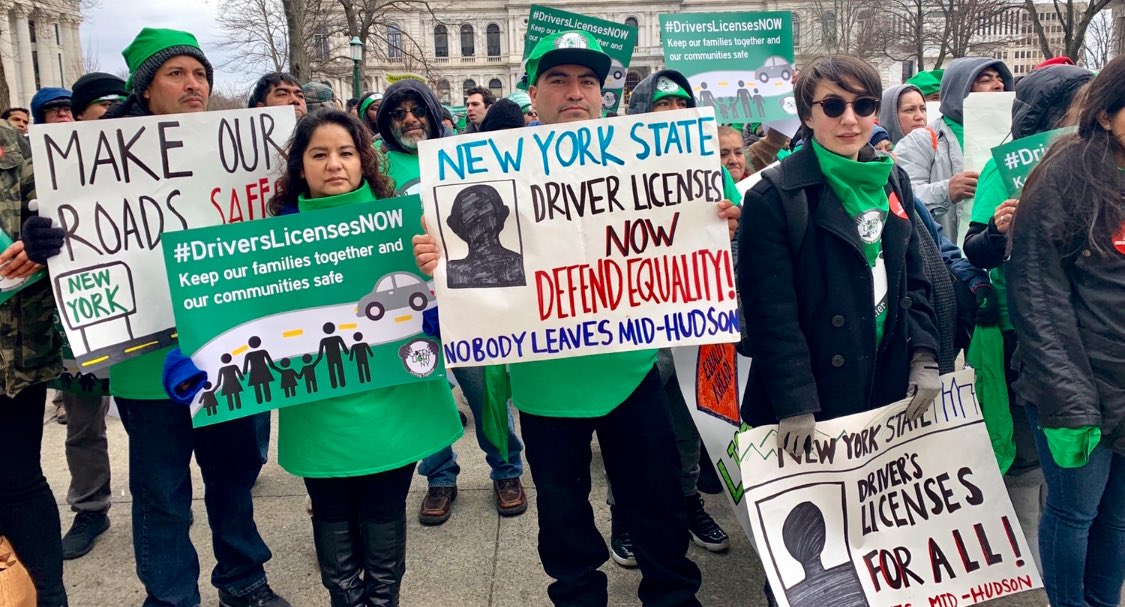
(photo: @EddieATaveras)
As a former Suffolk county police officer and detective, I think a lot about what keeps our communities safer. And one thing I know is that our roads are safer when everyone who is driving is licensed and insured. That’s why, as a state legislator, I believe New York should let all qualified drivers, regardless of immigrant status, follow the same process to get a driver’s license.
Driving is essential on Long Island. Throughout most of our region, you need a car to get to work and to drive your child to school or the doctor. Passing the Driver's License Access and Privacy Act would mean that 265,000 New Yorkers, including 51,000 Long Islanders, who currently don’t have access to a license would be able to safely drive to carry out their basic daily life necessities.
The roads in our state will be safer because every driver will go through the same process: submit an application, take a road test, and, if you pass, obtain a license. Making sure all drivers are licensed and insured means that more drivers are aware of traffic regulations and will likely reduce traffic-related incidents.
Roads are safer when all drivers can be tested, licensed, and insured. While research has shown that undocumented immigrants are particularly careful drivers, they are even safer when they have a state issued driver’s license. Various studies have concluded that ensuring equal access to licenses can reduce the incidence of traffic fatalities. And, in California, data show that within the first year of passing a similar policy to expand access to driver’s licenses, the number of hit-and-run accidents declined.
In addition to making our roads safer, restoring access to driver’s licenses to all New Yorkers can help build trust between local law enforcement and immigrant communities – a relationship that has been crippled by a series of attacks on immigrants and people of color by the Trump administration; the president went as far as encouraging police brutality in a 2018 visit to Long Island.
In the climate of fear that Donald Trump has created, members of our communities are more fearful than ever of interactions with law enforcement, which can lead people to not report crimes that they witness or of which they are victims. This is especially true when people don’t have access to a state identification document.
No one, regardless of immigration status, should have to fear contacting a police officer, whether it is to ask for help or to contribute to a solving a crime, for lack of documentation. Having a driver’s license will lead to thousands more current New Yorkers having access to an identification document that enables them to identify themselves as they drive on the road and proceed with their daily lives.
Restoring access to driver’s licenses will also be an economic win for our state. Immigrant New Yorkers already contribute enormously to our state’s economy -- contributing more than $100 billion annually as consumers, and more than $1 billion in taxes on top of that.
If the driver’s licenses bill, which would especially increase the number of immigrants with licenses statewide, were passed, the Fiscal Policy Institute has found there would be a further gain. Annual state revenues would increase by $57 million, and there would be a $26 million one-time boost in revenue, as people obtain licenses and purchase cars.
It’s also worth noting what this bill won’t do. The standard issue licenses that would be available to undocumented people would not be valid for air travel, for entering federal government facilities, or to vote. The standard licenses would simply enable members of our communities to access the roads and the insurance they need.
The Driver's License Access and Privacy Act would bring benefits to all Long Islanders through improved road safety, trust in law enforcement, and an economic boost. New York should not delay. This should be the year to restore access to licenses to all qualified drivers.
***
Phil Ramos is an Assembly member representing New York’s 6th Assembly District in Suffolk County. On Twitter @PhilRamos6AD.
***
Have an op-ed idea or submission for Gotham Gazette? Email This email address is being protected from spambots. You need JavaScript enabled to view it.




